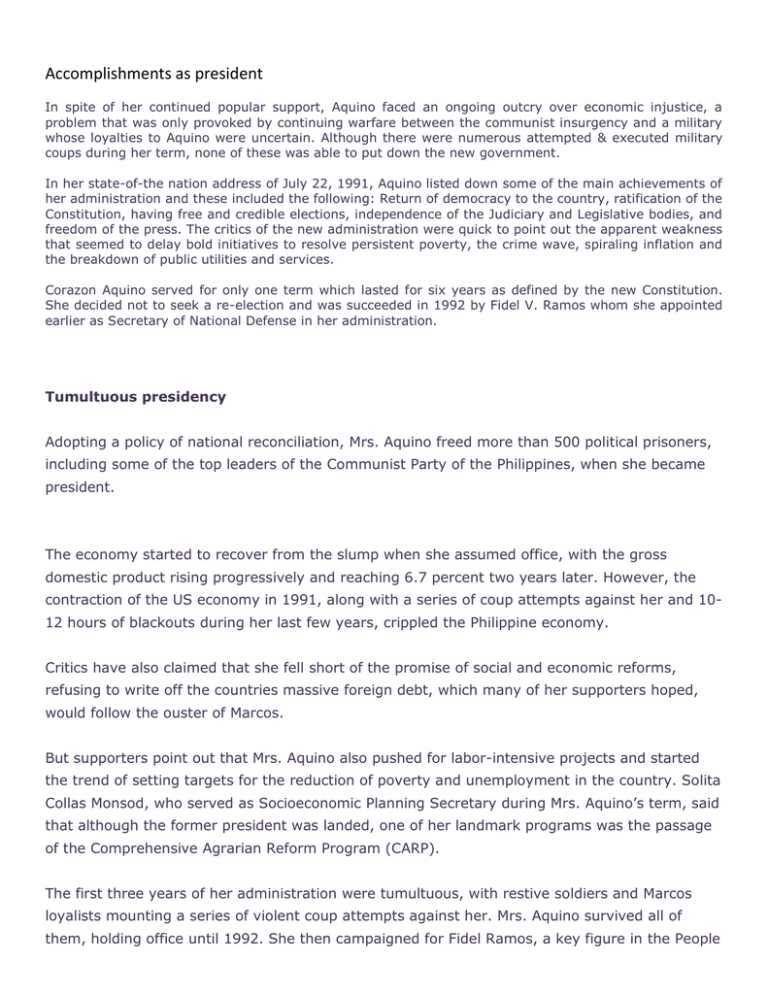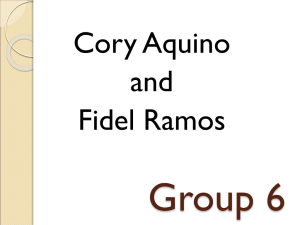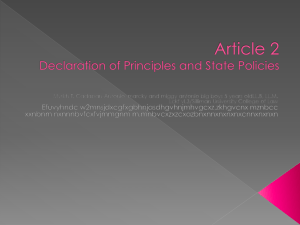Accomplishments as president In spite of her continued popular
advertisement

Accomplishments as president In spite of her continued popular support, Aquino faced an ongoing outcry over economic injustice, a problem that was only provoked by continuing warfare between the communist insurgency and a military whose loyalties to Aquino were uncertain. Although there were numerous attempted & executed military coups during her term, none of these was able to put down the new government. In her state-of-the nation address of July 22, 1991, Aquino listed down some of the main achievements of her administration and these included the following: Return of democracy to the country, ratification of the Constitution, having free and credible elections, independence of the Judiciary and Legislative bodies, and freedom of the press. The critics of the new administration were quick to point out the apparent weakness that seemed to delay bold initiatives to resolve persistent poverty, the crime wave, spiraling inflation and the breakdown of public utilities and services. Corazon Aquino served for only one term which lasted for six years as defined by the new Constitution. She decided not to seek a re-election and was succeeded in 1992 by Fidel V. Ramos whom she appointed earlier as Secretary of National Defense in her administration. Tumultuous presidency Adopting a policy of national reconciliation, Mrs. Aquino freed more than 500 political prisoners, including some of the top leaders of the Communist Party of the Philippines, when she became president. The economy started to recover from the slump when she assumed office, with the gross domestic product rising progressively and reaching 6.7 percent two years later. However, the contraction of the US economy in 1991, along with a series of coup attempts against her and 1012 hours of blackouts during her last few years, crippled the Philippine economy. Critics have also claimed that she fell short of the promise of social and economic reforms, refusing to write off the countries massive foreign debt, which many of her supporters hoped, would follow the ouster of Marcos. But supporters point out that Mrs. Aquino also pushed for labor-intensive projects and started the trend of setting targets for the reduction of poverty and unemployment in the country. Solita Collas Monsod, who served as Socioeconomic Planning Secretary during Mrs. Aquino’s term, said that although the former president was landed, one of her landmark programs was the passage of the Comprehensive Agrarian Reform Program (CARP). The first three years of her administration were tumultuous, with restive soldiers and Marcos loyalists mounting a series of violent coup attempts against her. Mrs. Aquino survived all of them, holding office until 1992. She then campaigned for Fidel Ramos, a key figure in the People Power Revolution, whose presidential victory is widely credited to Aquino’s endorsement. In an article commemorating the 20th anniversary of the people power revolt on the Philippine Center for Investigative Journalism website, Aquino was quoted as saying, “I don't know how they will judge [my presidency], but I just hope that they will realize that it was not an easy thing restoring democracy after a dictatorship. Also being the first woman president certainly had its problems and then we were dealing with a very strong military that were spoiled during the Marcos dictatorship." Legacy/funeral/ Political future of the Philippines, Gloria as president… LA Times 2009 A courageous woman who emerged as a reluctant leader at a time of national crisis, Aquino left a mixed legacy as president. Her government was beset by a series of bloody coup attempts -- seven in her six years in office -- by disaffected right-wing military officers and Marcos loyalists. Challenges from communist rebels, terrorists and armed Muslim secessionists, along with a series of debilitating government scandals, left her administration lurching from crisis to crisis and, it seemed, constantly on the edge of collapse. She appeared jinxed by a series of natural disasters that included a deadly earthquake, one of the century's worst volcanic eruptions at Mt. Pinatubo, floods, typhoons and a drought. Aquino also proved an inept and indecisive leader in her country's high-pressure and volatile political culture. Wary of wielding too much power, as Marcos had, she left agrarian reform to a newly elected Congress dominated by rich landowners, and thus little land changed hands in the feudalistic countryside. Her own family used a loophole in the law to avoid divestiture of Hacienda Luisita, a sprawling sugar plantation in central Luzon, the Philippines' main island. Her administration had little success in alleviating the grinding poverty that affects more than half the population or in stamping out the nation's endemic cronyism, graft and corruption. A staunch Roman Catholic, she gutted birth control programs in one of Asia's most crowded and poorest countries. And by the end of her term, the tortuous negotiations over the future of the U.S. military bases had led to a sharp decline in the Philippines' relations with the United States, its main trading partner and ally. The woman who was named Time magazine's Woman of the Year in 1987 and who won a standing ovation from a joint session of the U.S. Congress had lost much of the global goodwill that accompanied her accession to power. "While it was the restoration of democracy, [people power] was not the restoration of good government," Father Joaquin Bernas, a former advisor to Aquino, wrote at the end of her term. "We have come to realize that it is much easier to set up the external trappings of democracy than to make it work to the satisfaction of our people." Aquino appeared to dislike her job and, at the end, literally counted the days until she left office. But she did fulfill a key promise: She survived her term and presided over the first peaceful transfer of power in the tempestuous country in more than 26 years. "She led the restoration of democracy back to the Philippines," Fidel V. Ramos told The Times after he was elected to succeed Aquino in May 1992. "Of course she didn't do it by herself. But she will be remembered as having led the fight against the dictatorship." In her final State of the Nation address in July 1991, Aquino seemed to speak more to her failures than to her successes. "God knows, we have made mistakes," she said. "I hope that history will judge me . . . favorably . . . because, as God is my witness, I honestly did the best I could." Born Jan. 25, 1933, to Jose Cojuangco and Demetria Sumulong, affluent sugargrowers in central Luzon, Corazon Cojuangco was raised in luxury. The family moved to the United States after World War II, and she attended high schools in New York and Philadelphia before earning a bachelor's degree in French from Mount St. Vincent College in New York. Back in the Philippines, she married journalist Benigno "Ninoy" S. Aquino Jr. in 1954. They had five children and, after Marcos' election in 1965, Benigno Aquino increasingly led the opposition to the president's growing power. When her husband's activities led to his imprisonment at the start of Marcos' martial law period in 1972, Aquino visited him frequently but mostly stayed out of the limelight. Her first public appearance came in 1978, when she helped campaign for her still-incarcerated spouse in a race for assemblyman. She continued to live in the shadow of her husband after he was released under international pressure in 1980 and allowed to move to Newton, Mass., for a heart bypass operation. But in August 1983, the opposition leader returned to Manila and was gunned down at the airport by soldiers loyal to Marcos. His widow returned to the Philippines to lead an impassioned throng of supporters and sympathizers in a lengthy funeral march that became a unifying symbol for the anti-Marcos forces. Although she insisted she had no political ambitions, Aquino soon emerged as the most credible of Marcos' opponents. When she registered to run against Marcos after he called a snap presidential election for Feb. 7, 1986, Aquino listed her occupation as "housewife." Earlier, she had summed up her preparation for the post with a quizzical comment to reporters: "What do I know about being president?" Later, ridiculed by Marcos for her lack of experience, she replied: "It is true. I have no experience in lying, cheating, stealing and killing. I offer you honesty and sincerity in leadership." Wearing her signature yellow, she turned her campaign into a crusade, a Philippine passion play in which she played the saintly widow taking on the evil dictator. When Marcos claimed victory after an election tainted by massive fraud, Aquino launched a nonviolent civil disobedience campaign to protest the cheating. Then, on Feb. 22, 1986, a mutiny led by followers of Defense Secretary Juan Ponce Enrile broke out in a Manila suburb. Ramos, at the time the acting armed forces chief of staff, soon joined in. The mutineers declared support for Aquino, and the country's powerful Roman Catholic prelate, Cardinal Jaime Sin, called the faithful into the streets to block Marcos' forces. Three days later, Marcos fled aboard a U.S. Air Force plane bound for Hawaii. In a simple ceremony, Aquino declared "the long agony is over" and took over as president of the Philippines.








